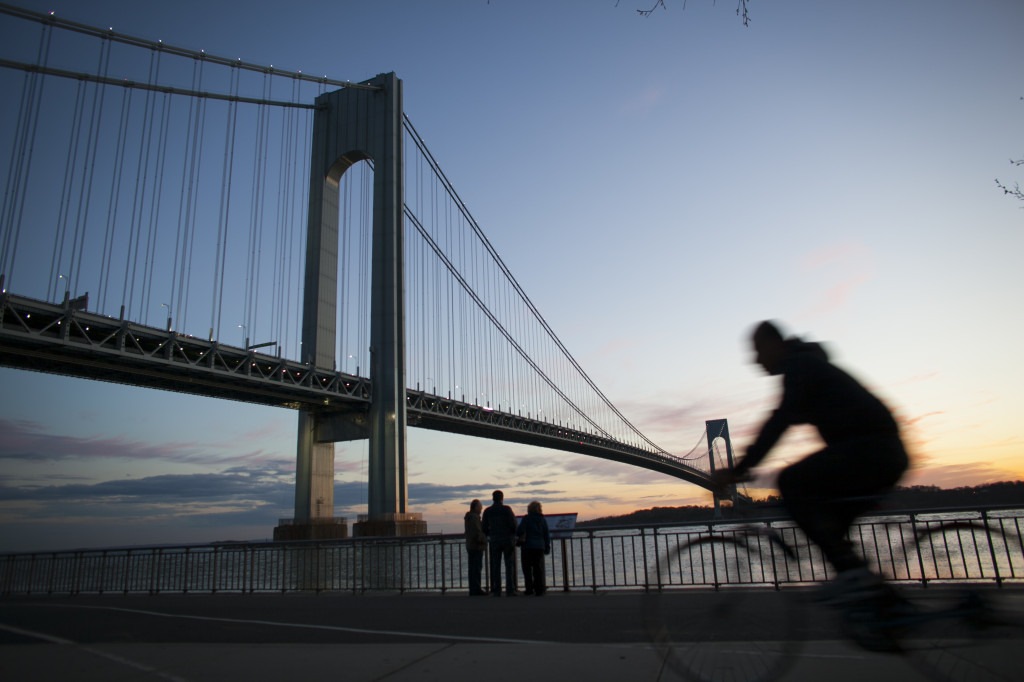Originally completed in 1964, the Verrazzano Bridge is the main missing link in the Harbor Ring route. Cyclists and pedestrians are permitted to cross the bridge only twice a year, during the Five Boro Bike Tour and the New York City Marathon.
The bridge’s 225-foot-high, 4,260-foot-long center span is the longest in the Americas. The towers are seen from all five boroughs, and all cruise ships and large container ships calling at the Ports of New York and New Jersey (5,000 annually) pass under the bridge. The views from the bridge of New York Harbor, the Statue of Liberty, and downtown Manhattan are spectacular. Rivaled only by San Francisco’s Golden Gate Bridge (which has pathways drawing thousands each day), New Yorkers and visitors should have access to this unequaled kaleidoscope of city, sea, and sky.
The Verrazzano was initially engineered to include pedestrian and bike pathways, which were never completed. In 1997, the firm that originally designed the bridge, Amman & Whitney, who also designed the George Washington, Whitestone, Triborough, and Williamsburg bridges, worked with the New York City Department of City Planning to release a report that analyzed the potential of adding the pathways to the bridge. That report highlighted four alternatives for adding the pathways that could be completed without limiting vehicle traffic over the bridge. The preferred alternative showed that the pathways could be constructed between the bridge’s suspender cables, similar to the pathway construction on the George Washington Bridge.
The Metropolitan Transportation Authority (MTA), which operates the bridge, recently announced plans to improve the Verrazzano Bridge by replacing the upper roadway deck, adding a High Occupancy Vehicle lane to the bridge, and redesigning the Brooklyn side approach. For a small cost increase, the project could include the construction of bicycle and pedestrian pathways on the bridge. There are many reasons why incorporating the pathways in the project would be a great idea and would benefit residents and visitors to New York City for years to come.
The Harbor Ring Committee has made significant progress advocating for a complete Verrazzano Bridge:
- In April 2013, the MTA announced that it would consider studying the addition of pedestrian and bicycle pathways as part of the 2015 Belt Parkway ramp reconstruction project.
- In August 2013, the MTA issued a Request for Proposals for “Development of Master Plan and Conceptual Design of Upper Level Approaches and Belt Parkway Connector Ramps at the Verrazzano-Narrows Bridge.” The RFP includes the study of bicycle/pedestrian pathways on the Verrazzano as the first of nine projects to be included in the requested bids for the Master Plan.
- In December 2013, the MTA awarded the contract to prepare the Master Plan, including the feasibility study for the pathways, to a Parsons Brinkerhoff/WSP Joint Venture. Excerpts related to the pathway from the PB/WSP JV proposal to the MTA are available here. Excerpts related to the pathway from the MTA’s contract with PB are available here. The results of the feasibility study should be available in late 2014 or early 2015. The Harbor Ring Committee has been encouraging the MTA to receive public input into the feasibility study before the study is completed.
In honor of the bridge’s 50th anniversary in 2014, the MTA is taking meaningful steps forward to finally complete the bridge with pedestrian and bike pathways. The pathways would be the keystone of the Harbor Ring, and would have tremendous benefits for the region.

